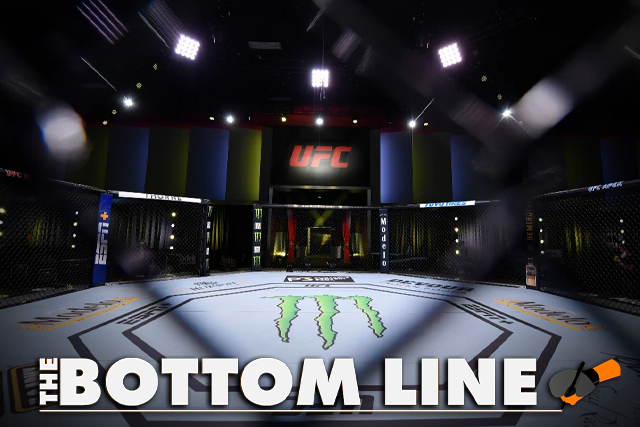The Bottom Line: In Defense of the UFC Apex

Editor’s note: The views and opinions expressed below are those of the author and do not necessarily reflect the views of Sherdog.com, its affiliates and sponsors or its parent company, Evolve Media.
Advertisement
As we move further away from the worst of the coronavirus pandemic, the telltale signs of its disruption have gradually gone away. The airport crowds are back, the masks are less common and restaurants are bustling again. In MMA, one of the staples of the pandemic persists: shows at the friendly confines of the UFC Apex.
The UFC Apex shows were at first strictly a necessity. Fans weren’t allowed at shows, and arenas were largely going unused. The Apex was a spot owned by the Ultimate Fighting Championship where it could run in a closed, safe environment. Some great moments took place there, and there is something to be said for a quiet environment that allows the audience to hear the impact of the punches, kicks and knees. However, the calls have gotten louder of late for the UFC to stop running at the Apex in 2023 and return to a full touring schedule.
It’s understandable that fighters wouldn’t want to fight at the
Apex, just like most fighters would rather fight at Madison Square
Garden or T-Mobile Arena rather than at a smaller arena in a
smaller market. The biggest arenas tend to host the biggest events,
and being on a big stage is good for your brand. It also makes it
easier for all your friends and family to attend, and the reaction
when you win is a shot of adrenaline. It’s also understandable
hardcore fans watching all the shows enjoy the energy of the bigger
arenas. However, that doesn’t mean it’s a good idea to dump Apex
shows altogether.
The UFC Apex shows are good for the sport, clearly and unequivocally. UFC business has thrived during the pandemic even with big arena events growing rarer, and that’s no accident. Before the pandemic, with UFC running events at major arenas practically every week, there was pressure to make sure to provide major league cards every time out. When a fight fell through, which happens all the time, cards needed to be arranged in order to make sure no card got too weak. This often meant grabbing major fights from pay-per-views to support other cards.
With the Apex, there is no such pressure. It’s rare that there will be two fights of serious immediate consequence on an Apex card now. Sometimes there isn’t even one. They’re secondary events, and nobody has their feelings hurt over it. Fans can tune in or not. This then allows the big fights to be saved up for stacked pay-per-views and select touring events. The UFC runs so much content these days that only a very small percentage of the audience is watching everything.
Allowing fans to catch most of the top fights without an overwhelming time investment keeps the sport healthy and strong. It may mean a little less energy for those of us watching the most minor cards, but that’s preferable to having to make minor cards a little bigger and in turn siphoning off fights from major events that more fans are actually going to watch.
The perfect example of this conundrum came at UFC 279, where the organization had to completely rearrange the card a day in advance. It turned out better than those types of last-minute major changes usually do, but it was the sort of chaos UFC tries its best to avoid. It was also the first time that’s happened in years; there was a time when it would happen two or three times in a single year. That’s because those types of rearrangements only become necessary when cards get thinner and can’t afford to lose a top fight.
For most of the pandemic, the UFC would roll out a series of Apex cards with weaker lineups and then roll out a big time pay-per-view card. If a fight fell through on the pay-per-view, there was enough depth that it wasn’t missed much. However, in the weeks and months leading into UFC 279, the UFC started upping its road schedule. It ran major non-PPV cards in Long Island, New York, and London, San Diego and Paris. Each of those events was significantly stronger than your average Apex card. That left less for UFC 279, which in turn couldn’t stand as a pay-per-view event without Nate Diaz. That used to be common. It became a rarity during the Apex era but will become common again with a full touring schedule.
This isn’t to say improvements couldn’t be made to the Apex presentation. More fans could be let in to allow for a better environment. A small crowd at affordable ticket prices would understand they’re not necessarily going to be getting a star-studded lineup and will provide enthusiasm and energy without expectation. The model could be the old World Extreme Cagefighting shows at the Hard Rock Hotel and Casino in Las Vegas, an incredible environment for fights that helped build that brand. However, if the UFC goes back to all touring, the sport will be worse off for it, even if the Apex detractors don’t connect the dots on the cause and effect.
« Previous By The Numbers: Mackenzie Dern vs. Xiaonan Yan
Next Bo Nickal ‘Not a Hater in Any Way’ on Raul Rosas Jr. Earning UFC Deal Before Him »
More




 UFC News & Features
UFC News & Features

